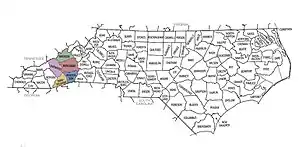Asheville metropolitan area
The Asheville metropolitan area is a metropolitan area centered on the principal city of Asheville, North Carolina. The U.S. Office of Management and Budget defines the Asheville, North Carolina Metropolitan Statistical Area, a metropolitan statistical area used by the United States Census Bureau and other entities, as comprising the four counties of Buncombe, Haywood, Henderson, and Madison.[1] According to the 2010 United States Census, the area's population was 424,858.[2]

Communities
Places with more than 50,000 inhabitants
- Asheville (Principal city)
Places with 5,000 to 15,000 inhabitants
Places with 2,500 to 5,000 inhabitants
Places with 1,000 to 2,500 inhabitants
Places with less than 1,000 inhabitants
- Hot Springs
- Marshall
- Montreat
- Rosman
- Saluda (partial)
Unincorporated places
- Arden
- Barnardsville
- Bat Cave
- Breakaway
- Candler
- Chesnut Hill
- Gerton
- Joe
- Jupiter
- Leicester
- Luck
- Oteen
- Petersburg
- Ridgecrest
- Skyland
- Swannanoa
- Trust
- Walnut
Demographics
As of the census[3] of 2000, there were 369,171 people, 154,290 households, and 103,653 families residing within the MSA. The racial makeup of the MSA was 91.49% White, 5.15% African American, 0.37% Native American, 0.56% Asian, 0.03% Pacific Islander, 1.33% from other races, and 1.06% from two or more races. Hispanic or Latino of any race were 3.15% of the population.
The median income for a household in the MSA was $34,921, and the median income for a family was $41,952. Males had a median income of $30,308 versus $23,069 for females. The per capita income for the MSA was $19,031.
Combined Statistical Area
The Asheville-Brevard Combined Statistical Area is made up of five counties in western North Carolina. The statistical area includes the Asheville Metropolitan Statistical Area and the Brevard Micropolitan Statistical Area.
See also
- North Carolina census statistical areas
- List of cities, towns, and villages in North Carolina
- List of unincorporated communities in North Carolina
References
- "May 2018 OES Metropolitan and Nonmetropolitan Area Definitions". www.bls.gov. Retrieved 2019-11-30.
- "United States Census 2010".
- "U.S. Census website". United States Census Bureau. Retrieved 2008-01-31.

